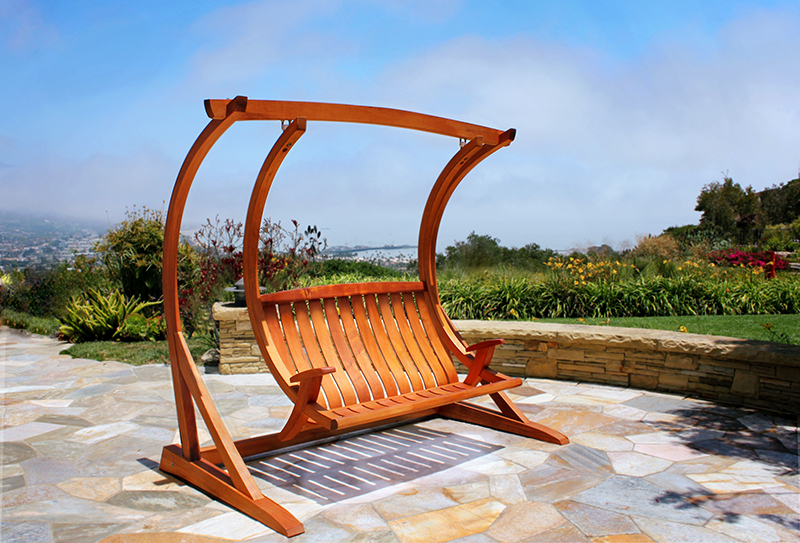Brian Boggs all but stumbled upon his vocation when he built his first chair in 1982. “I had two goals,” recalls the now renowned chairmaker, based in Asheville, N.C. “I wanted to see what chairmaking was like, and I wanted to make a set of chairs to use at home.”
The then 23-year-old Boggs had been taking art lessons since the age of 8, and he always believed he’d be an artist. “Although my deep love affair with trees began early on,” he adds, “I never thought of furniture as art.” Guided by John Alexander’s seminal book “Make a Chair from a Tree,” Boggs followed the steps of an ancient craft tradition to produce a simple ladderback side chair. The craft resonated immediately with him in a way that painting and drawing never had.
“Bringing art into working with trees was like a drug,” he says. “I bought logs, split them, and carved each piece by hand. Going directly from the organic and sensuous form of the tree to what my mind could envision was exhilarating. I had just gotten to a point of frustration with my art, but woodworking allowed me to be expressive and productive.” Boggs’ home never saw that matching set of dining furniture because, as soon as a neighbor saw the new chair, he ordered a set for himself.
“I’ve been filling orders ever since,” says the acclaimed designer, who works with his wife, Melanie, and a team of four craftsmen out of an ever-expanding workshop in Asheville supplying indoor and outdoor seating to discerning clients from Florida to California and overseas.
More than beautiful sculptural pieces, however, Boggs’ chairs are renowned for their comfort and durability. “For me, it’s all about how to form wood fibers to what a human body is like,” he explains. “It has been an organic evolution. I’ve developed my own system, hand tools and specialized machines for some of the work I do.Boggs’ chairs are in the collections of some of America’s best-known woodworkers and furniture collectors, and have also taken home Best in Show accolades at prestigious national events such as the Fine Furnishings Shows, held in Wisconsin and Rhode Island each year.
“Once I became fluid with the skills, I could be more creative. I was inspired by old Appalachian forms, old pieces that are completely wrought by hand. Then I saw a hole in the market – no one was making a fine chair that fitted the human body.
“Office chairs built of metal and padding are designed to be comfortable, but if you try to find a very good handmade wood chair that’s ergonomic, you’ll be hunting for a long time.”
.jpg) .jpg) |
Boggs combined his regard for historic regional design with his search for comfort to produce a series of ladderback, fan back and woven back chairs sculpted to be both beautiful and extraordinarily comfortable. Backs and seats are both integral to the design, he points out, and his ergonomics research was simple. “I’ve owned a human body all my life,” he smiles.
Boggs’ love affair with trees has deepened as his knowledge has grown. He buys wood from North Carolina loggers who practice sustainable wood harvesting, and has also developed an environmentally sound program for procuring mahogany from Honduras that supports sustainable forest management.
Old city trees are among his favorite sources for wood. “Farmed timber is approximately 80 years old, but city trees can be older than that,” he explains.
He also works with a variety of woods and prizes each for its individual properties. “Cherry and walnut arepretty, and so is mahogany. I make the rungs from oak, but my favorites are red maple and hickory. Old chairmakers loved those two woods, and now I know why. I love their working properties as well as what they offer structurally.”
His regard for trees is poetic. “I think of it as putting the tree back together so that, in its second life, its beauty and durability are preserved.” As his business has grown, Boggs has added tables, beds and custom case goods to his line, but he still strives for perfection in seating.
“I am developing what I call the Water Chair,” he explains. “It will be super lightweight, airy and elegant. It will also be patented. This design is important, it requires techniques I have yet to develop, and it will require testing.
“By watching how things fail, I learn a lot about structural integrity. This chair will be my masterwork if I succeed with it, otherwise it will stay in the closet.” He looks back to his early fine art training as useful groundwork in principles of design. “I am made to be a chairmaker,” he says.
For more information on Brian Boggs furniture, visit brianboggschairmakers.com.


